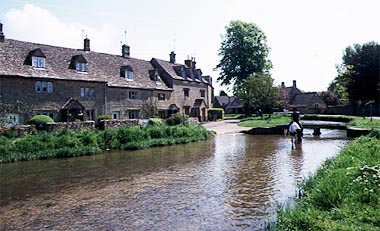
Lower Slaughter.The Windrush is a tributary of the Thames. The Windrush has its headwaters in a spring high on the Cotswold Hills to the East of Cheltenham. Here water seeping through the limestone rocks forms an underground water table that rises and falls with the seasons. Whenever the water table reaches the surface, that is where the Windrush begins. In an area with little surface water, most of the villages on the dip slope of the Cotswolds nestle at the bottom of the upper valley by the river. This is an area of quite steep valley sides and there is little opportunity for villages to spread up the valley sides, so they tend to be long and thin riverside settlements. Bourton on the Water is the first town along the valley, little more than a village really and built where the valley widens and the floor flattens. Here a number of artificial ponds have been created as a result of extensive excavation of the thick gravels which fill the valley bottom at this point. These gravels were brought down from the Cotswold Hills late in the Ice Age, when the limestone was frozen and much more water washed down from the hills than happens today. In places the gravel is up to 8m (25ft) thick. Larger excavations of the same kind make up the Cotswold Water Park, a little to the south on the main stem of the Thames. Flowing within limestone, the river continues its eastward path through sparsely populated countryside to the town of Whitney. Here the river water was once used as a source of power, starting one of the earliest blanket factories in the world. The Windrush enters the Thames just to the south east of Whitney.
The old water-driven textile mill still stands at Lower Slaughter. To its right a steam engine was later installed.
The River Windrush just below Bourton on the Water. The wide valley was formed at the end of the Ice Age when rivers were carrying away water from melting ice sheets. The modern river flows within this ancient valley.
|